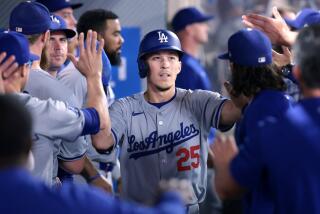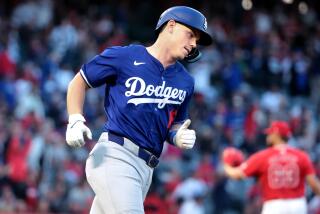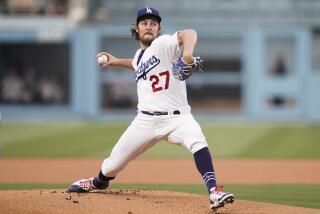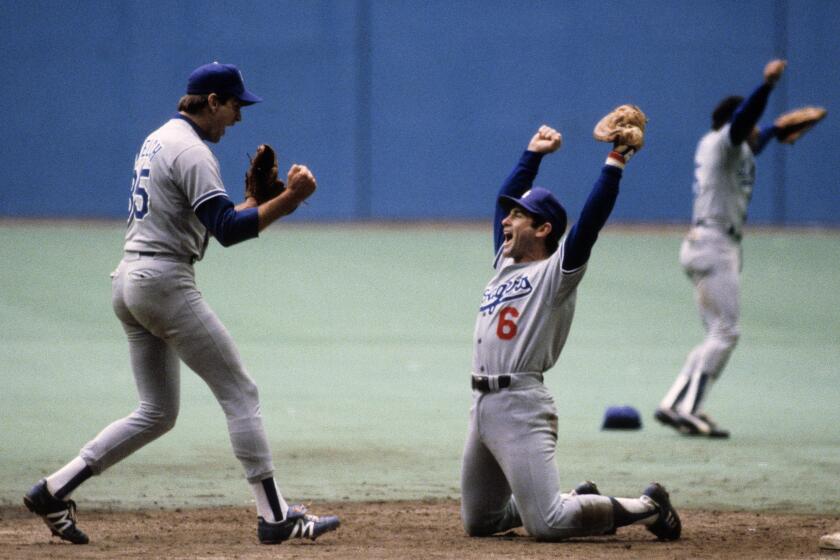Samuel Stepping Front and Center : Baseball: Is he a second baseman playing the outfield? Or an outfielder who will eventually play second base?
VERO BEACH, Fla. — The black baseball gloves arrived earlier this week, wrapped in plastic. Juan Samuel picked them up, felt them, then shoved them into the bottom of his locker with a thunderous laugh.
Second baseman’s gloves.
“I will play center field,” Samuel pronounced. “Center field.”
If he does not convince you, it is because he has not yet convinced himself. But too late to back out and too early to plead failure, Juan Samuel has reached a personal warning track. There is nowhere else to go. There is nothing else he can be.
And so today in Orlando, Fla., in the exhibition opener against the Minnesota Twins, he will take his place as the Dodger center fielder of the future.
Or least, of the next month or so.
Those focused on Samuel--and that will be just about all of the Dodgers--will see a player race across the grass like something out of a high-speed movie. They will see a player who can throw the ball as hard as a pitcher, only twice as far. But mostly, they will see questions.
Can this two-time All-Star second baseman play center field when, two months ago, he said he didn’t want to play center field? Can he play center field until some club officials get their way and trade for someone such as Philadelphia’s Len Dykstra, returning Samuel to his original position? Can he play center field, period?
How long does he expect to keep those black gloves hidden?
Maybe the best answer comes from Samuel’s friend Alfredo Griffin.
“Juan is very happy to be a Dodger,” he said. “And in this game, when you are happy somewhere, you’ll do just about anything.”
Not exactly a ringing endorsement, but the Dodgers knew they were taking a chance when they acquired Samuel last Dec. 20 from the Mets for Mike Marshall and Alejandro Pena.
They knew Samuel was unhappy last season. He was converted to a center fielder by the Philadelphia Phillies because, he says, they wanted their local hero to play second base, and they offered him a multiyear contract not to complain.
“I show I can play second base. I make All-Star teams, and guys who have played longer than me have not made All-Star teams,” he said. “But they wanted to bring in Tommy Herr, who used to live in Delaware. Our general manager, Lee Thomas, and Manager Nick Leyva knew Herr from St. Louis and they wanted him.
“I finally say, ‘You give me a multiyear contract, I will do it.’ And they did. So I couldn’t say no.”
That two-year deal was worth $2.8 million.
As he struggled in the outfield, learning to make catches he once thought impossible and over-the-head throws he thought unimaginable, the unthinkable happened. He forgot how to hit. His offense dropped and his pride was dented, and then, as if that wasn’t enough, on June 18 he was traded to the contending Mets.
“To be put in pressure situation when you are still learning a position, it was not fun,” Samuel said. “It’s not good for your head.”
Not to mention your statistics. By the end of the year he was hitting just .235 with 11 homers and 48 runs batted in, all career lows.
The Dodgers knew all this. So why the trade? Some will say because they were so desperate for a center fielder, they would have traded for anybody who could spell it. Others will say it was because second baseman Willie Randolph will be 36 and without a contract when the season ends, and that Samuel, 29, would be a good replacement if he can survive this summer.
But perhaps the best explanation is, they made the deal because of The Manny Mota Show.
Those who have never heard of it haven’t been in front of a television set in the Dominican Republic on Saturday mornings from 11:30 a.m. to noon. Although Mota is admittedly no Carson--he does no monologue--the Dodger instructor hosts a weekly sports talk show with a variety of guests, including a recent appearance by Dominican President Joaquin Balaguer.
Some of his guests are so big, Mota turns their appearance into a two-part series. Last winter, Samuel was one of those guests. During a Wednesday afternoon taping, Mota asked him what teams he would like to play for. Samuel mentioned the Dodgers.
By the time Samuel had arrived home from the studio, his phone was ringing. He had just been traded to the Dodgers.
“We knew he wanted to come here,” said Mota, who has become Samuel’s personal instructor. “And being such a great, great athlete, we knew we could work with him. We knew that if he wanted to be with us, we could make him a great center fielder.”
“I was very happy with the trade,” Samuel said. “The only thing was, we had to go back and re-tape the show.”
The Dodgers took advantage of that happiness a couple of days after the deal when Manager Tom Lasorda took Samuel to dinner and casually broke the news that he would not be moving back to second base. In true Lasorda fashion, he said something like, how would you like to be the greatest center fielder in baseball history?
“I said, ‘Well, if that’s what you want, I am willing,’ ” Samuel recalled. “I want to play for the Dodgers. I like the weather. I like the atmosphere.”
He then showed them how much by working as a center fielder three days a week with Mota at a local university, chasing fly balls, working on throws, practicing footwork. Mota would schedule a 9:15 a.m. workout, but he said it would not be surprising if Samuel arrived 45 minutes earlier.
“Manny made everything so easy, I could not wait to get to work,” Samuel said. “Also, I get up early because of a baby in the house.”
That work has continued this spring, with Samuel and Mota often together in the outfield during batting practice and later. The Dodgers are reassured by his work ethic.
“I really didn’t find the switch to be too hard,” said Bob Bailor, a former Dodger who made the transition from second base to the outfield in triple-A in 1974. In 11 ensuing major league seasons he played 425 games in the outfield and 419 in the middle infield.
“Center field is actually easier than the infield,” said Bailor, manager of Toronto’s triple-A Syracuse club. “You have the batter right in front of you, you can stretch your arm out on throws, you have a lot of room to run. And you have less responsibility than second base.”
The job, according to Samuel, still has its drawbacks.
Such as predictability: “The ball does all kinds of crazy stuff out there!” Samuel exclaimed.
And endurance: “I get tired just running back and forth to the position,” he said.
It remains unknown whether, a couple of months into the season, Samuel will succumb to what he perceives as the biggest drawback: That center field is not second base.
“I don’t know,” Samuel said, laughing. “Ask me in June.”
More to Read
Are you a true-blue fan?
Get our Dodgers Dugout newsletter for insights, news and much more.
You may occasionally receive promotional content from the Los Angeles Times.










